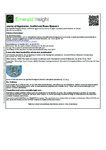Alterophobic bullying and pro‐conformist aggression in a survey of upper secondary school students in Ireland
| dc.contributor.author | Minton, Stephen | |
| dc.date.accessioned | 2019-10-22T12:33:34Z | |
| dc.date.available | 2019-10-22T12:33:34Z | |
| dc.date.issued | 2012-04-06 | |
| dc.identifier.issn | 1759-6599 | |
| dc.identifier.issn | 2042-8715 | |
| dc.identifier.uri | http://hdl.handle.net/10026.1/15020 | |
| dc.description.abstract |
Purpose: "Alterophobia", which refers to prejudice directed towards members of "alternative" sub-cultures, has been manifest in criminal cases such as the murder of Sophie Lancaster in 2007 (UK). The purpose of this paper is to investigate whether alterophobia is also evident in patterns of school bullying behaviour. Design/methodology/approach: A total of 820 fifth-year students (16-17 years old; 339 male (41.3 per cent), 481 female (58.7 per cent), at nine secondary schools in Ireland, were asked to respond to a short, specifically constructed questionnaire, concerning membership of groups and sub-cultures, and bullying behaviour. Findings: Self-identified membership of sub-cultures was infrequent; reports of perceiving that one was identified by others as a member of a sub-culture were more frequent. Self-identified members of sub-cultures reported both having been bullied and having bullied others more frequently than did members of the general sample. Participants expressed that members of "alternative" sub-cultures ("moshers/rockers", "goths", and "emos") were more likely to be bullied, and that members of "non-alternative" sub-cultures ("chavs" and "D4s") were more likely to bully others. It was concluded that "alterophobic bullying" was a reality, and that members of "alternative" sub-cultures may be considered to be "at risk" of being bullied. Research limitations/implications: This study is based on a simple and original questionnaire, and therefore provides indicative/exploratory findings; if a subsequent survey method were attempted, equivalent definitions of sub-cultures would have to be ensured. It is possible to see how alternative research methods (e.g. focus groups) would permit for advances in understanding in this area. Practical implications: It is suggested that specific mention of alterophobia in school anti-bullying policies should be made, and that closer attention to the psychology of prejudice and "pro-conformist aggression" could inform future anti-bullying efforts. Originality/value: The paper is the first to focus explicitly on "alterophobia", and provides the first empirical evidence on "alterophobic bullying". © Emerald Group Publishing Limited. | |
| dc.format.extent | 86-95 | |
| dc.language | en | |
| dc.language.iso | en | |
| dc.publisher | Emerald | |
| dc.subject | Pediatric | |
| dc.subject | Violence Research | |
| dc.subject | Youth Violence | |
| dc.subject | Mental health | |
| dc.subject | 16 Peace, Justice and Strong Institutions | |
| dc.title | Alterophobic bullying and pro‐conformist aggression in a survey of upper secondary school students in Ireland | |
| dc.type | journal-article | |
| dc.type | Journal Article | |
| plymouth.issue | 2 | |
| plymouth.volume | 4 | |
| plymouth.publication-status | Published | |
| plymouth.journal | Journal of Aggression, Conflict and Peace Research | |
| dc.identifier.doi | 10.1108/17596591211208292 | |
| plymouth.organisational-group | /Plymouth | |
| plymouth.organisational-group | /Plymouth/Faculty of Health | |
| plymouth.organisational-group | /Plymouth/Faculty of Health/School of Psychology | |
| plymouth.organisational-group | /Plymouth/REF 2021 Researchers by UoA | |
| plymouth.organisational-group | /Plymouth/REF 2021 Researchers by UoA/UoA04 Psychology, Psychiatry and Neuroscience | |
| plymouth.organisational-group | /Plymouth/Users by role | |
| plymouth.organisational-group | /Plymouth/Users by role/Academics | |
| dc.identifier.eissn | 2042-8715 | |
| dc.rights.embargoperiod | Not known | |
| rioxxterms.versionofrecord | 10.1108/17596591211208292 | |
| rioxxterms.licenseref.uri | http://www.rioxx.net/licenses/all-rights-reserved | |
| rioxxterms.type | Journal Article/Review |


